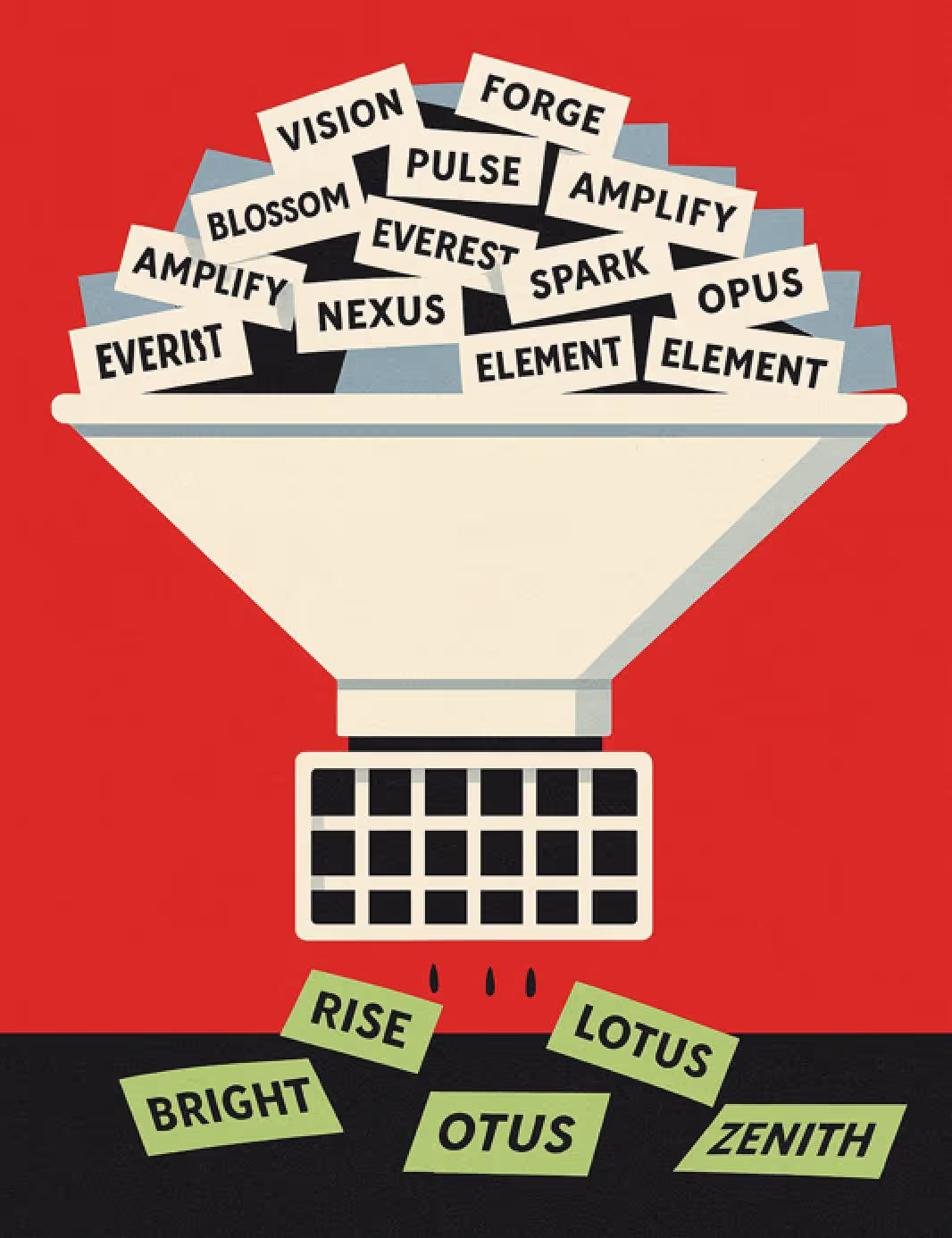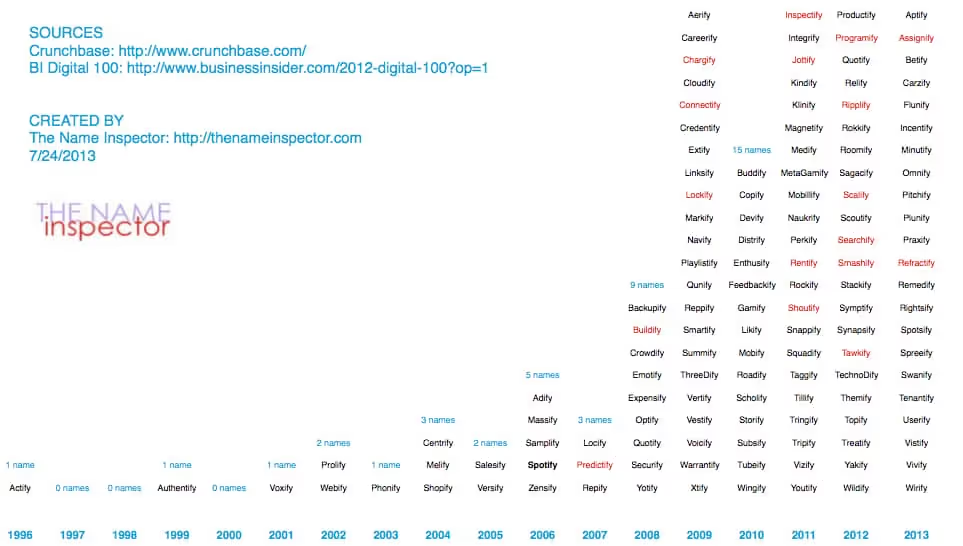Growth Newsletter #263
Naming your brand, product, or service offering is incredibly important, but notoriously difficult.
A killer name can give you a major leg up, and an unclear or confusing name can hold you down.
As someone who’s named 15+ brands for clients, I’ve found repeatable techniques and frameworks that help bring structure to an otherwise chaotic process. It’s part system, part intuition. And that balance is usually how you get to a name that’s distinct and defensible.
You may already have a great brand name, but your next side hustle, venture, or buddy’s startup might benefit from what years of naming projects have taught me.
-Gil
This week's tactics
How to Name Anything, A Blueprint
Insight from Gil Templeton - Staff Writer
Step 1: Warm Up With Name Archetypes
To begin your naming project, let’s start by establishing some common categories of names. You’ll naturally gravitate toward some buckets over others, but keep your ideation broad at first. Buckets you don't initially gravitate towards might end up leading you somewhere.
- Descriptive: These names tell you exactly what the company does. Clear, literal, and SEO-friendly, but not too unique or aspirational. Ex. General Motors, The Weather Channel
- Abstract: Made-up words that have virtually no meaning or connotation, but can come to mean something over time. Often catchy and distinct. Ex. Xerox, Hulu, Dasani
- Evocative: Names that hint at a larger story, emotion, or cultural idea, inviting interpretation and storytelling. Ex. Robinhood, Patagonia
- Functional-Fresh: Names that reference what the product does, with a playful or metaphorical twist. Fun and somewhat intuitive. Ex. Swiffer, Pinterest
- Founder’s Name: Using the founder’s name or a variation to signal legacy, craft, or prestige. Common for food & bev, DTC, and fashion. Ex. Ben & Jerry’s, Chanel
- Compound: Portmanteaus formed by two words smashed together to create something new and memorable, great at signaling multiple ideas. Ex. Facebook, YouTube
Keep in mind, this list of categories isn't exhaustive, and there’s certainly no right or wrong place to begin. This is just a good way to ground ourselves and get the ideas flowing.
Exercise: Look at 8–10 brands you love, and see if you can put each of their names into one of the categories above. Some might fit into a couple categories, and some might fall into less common categories not listed here.
Step 2: Play the Numbers Game
Like most creative exercises, naming is a numbers game, where a higher quantity naturally leads to higher quality. Remember, Da Vinci had hundreds of projects that were unsuccessful, and only a couple that endured.

For example, a famed study (retold in Art & Fear) split a pottery class into two groups: one graded solely on sheer quantity of their pottery output, the other on creating a single perfect pot. Each time, the quantity group “accidentally” produced the best pots, simply by throwing more clay and learning from each attempt.
In this spirit, try to riff with a partner or two in this early phase. Create a fun and open space where there are no bad ideas (even though 95+% of them will certainly be bad ideas). Like improv comedy, it’s all about “Yes, and…” at this stage.
Write down anything that comes to mind and don’t linger. Keep going. And going. And going.
And if you don’t have a partner, keep your keyboard clicking, your pen moving (or your voice dictating into AI). Inertia is your friend. You should be aiming for a couple hundred names.
Exercise: Generate 50+ names for each archetype category, for a total of 300-500 names. Store these in a Google Sheet to review later. This process can go faster than you think, especially with AI.
Routes and Resources to Riff With
While you’re in the “quantity” phase, here are some tools or prompts that can help you iterate.
- Embrace Latin roots: Dig into relevant root words (e.g. port, aqua, vis, dict) then combine or augment them in different ways. These can be somewhat of a cheat code, clueing people in on what your product might do or solve (even if it’s a 100% made up word).
- Translate key words in other languages: Sometimes hearing a boring English word in another language can add some flair or help you unlock a new word altogether.
- Use word finder tools: I always have a Litscape tab open during a naming project. The “words containing sequence” tool helps you find all words that contain your chosen sequence of letters.
- Common idioms and sayings: Let’s say you’re naming a home improvement business. Look up any and all idioms having to do with houses, and you might find part of a phrase or saying that brings it all home.
- Portmanteaus via AI: ChatGPT is pretty good at understanding the assignment when it comes to two-part word mashups. Keep your prompt simple, instructing it to combine two relevant themes or motifs into non-existent words that retain typical phonetic structures.
- Tap into the senses: Think about what your product or service looks, feels, sounds, or even tastes like, then brainstorm around those qualities. Sensory words often carry implicit emotion, which helps your name do more with less.
- Map out your metaphors: Build a mind map of symbolic themes associated with your brand (e.g. growth = gardens, rocket ships, compounding interest). These detours can lead to surprising but resonant name ideas.

Step 3: Thin the Word Herd
Once you’ve spent enough time amassing a huge batch of names in your Google Sheet (hopefully a couple hundred), it’s time to trim the list down to the cream of the crop.
First, go back through your master list and highlight the names that feel like they have the most potential.
Maybe there were a couple you fell in love with when you wrote them down, or maybe fresh eyes give you a newfound appreciation for names that didn’t trip your trigger initially.
There’s no hard and fast rule here — or anywhere in this meandering process for that matter — but I’d aim for a batch of your best 30+ names at this point.
Exercise: Narrow down to your top 30 or so names. Look for ones that: (1) made you smile when you wrote them, (2) feel fresh with new eyes, (3) could work across multiple products, (4) you'd feel proud to tell your mom about.
Step 4: The Heartbreaker, Check Availability
Up until now, we’ve been living in a naming fantasy land, but it’s time to face reality. Get ready to say goodbye to the majority of the selected names you’ve fallen in love with, because most of them will be unavailable for you to use IRL (in real life). Here’s how you can check for viability.
- Give it a Google: The quickest way to see if a brand with a name like yours exists (especially within your category) is to Google it. If there’s a brand with the same name in an unrelated industry, you’re usually safe, as long as it wouldn’t be confusing to a consumer. This is why Delta Airlines and Delta Faucets can coexist peacefully.
- Do a trademark search: Ah, good ol’ government websites. Use the US Patent & Trademark Office TESS tool to check whether your name is trademarked by someone else already. You can often see who owns the trademark in case you wanted to do further research or reach out directly.
- Check for URL availability: I use GoDaddy.com to see if my name’s “.com” version is available, and if not, I see which other options might fit the bill. The closer you can get to “brandname.com” the better, usually. This is more of a consideration than a black-and-white decision — but if an established company is already using your name, owns the best URL, and has a high SEO ranking for your name, is that an uphill battle worth fighting?
If the .com URL is already taken for a name you love, try these prefixes: get-, hey-, try-, use-. Or try -app, -co, -hq as suffixes. The D2C healthcare brand Hims launched in 2017 under the domain Forhims.com before they could acquire the cleaner Hims.com domain in 2020.
- Salvaging favorites: You might have already listed some existing names with funky or off-kilter spelling (e.g. Lyft or Tumblr), but now can be a time to push words into more unique territory to make them distinct from competitors or established brands in other industries, especially if there may be some confusion.
- Try dropping a letter (“Quick” becomes “Quik”)
- Try swapping letters with similar sounds (“Light” becomes “Lyte”)
- Try adding extra letters (“Drop” becomes “Dropp”)
Misspellings may have worked for Flickr in 2004, but proceed with caution. Every dropped vowel or swapped consonant adds friction, at least at first. People will generally type the 'correct' spelling first, potentially sending traffic to competitors. Only do this if your name is worth the education tax (and the obligatory investor eyeroll).
- Check Your Domain's History: Even if a domain is available, that doesn’t guarantee a clean history. A close friend of mine picked what seemed like the perfect URL with his his ideal ".com" address for a cheap price. Months later, he learned his emails were going to spam folders because the domain was an adult site years prior. It was still blacklisted, and he had to rebrand the whole company. Sigh.
While it's great to sound relevant and current, leaning into the major trends can sometimes leave you lost in the noise. Take a look below at the exponential boom of names ending in "-ify" and how they start to blend together after a while.

Step 5: End With the Gut-Checklist
After checking the availability of 30ish favorite names, you’ll likely end up with 5ish viable options that are legally safe and pass your initial vibe test.
If there’s a clear, legally viable winner in the group, great. Test that option against the following criteria below. If you have a couple contenders you feel good about, do the same to see if one rises above the rest.
If you need a sounding board or another set of eyes, ask a trusted partner or an expert in the space to test the name against the following questions. However, be cautious about opening this up to a group. It can be hard to achieve consensus or useful feedback through a larger audience.
Your Gut-Checklist:
- Can someone pronounce it correctly after reading it once?
- Can someone spell it correctly after hearing it once?
- Is it easy to remember?
- Does it feel like the future of your brand?
- Could it stretch to your future products or offerings?
- Would you be proud to wear it on a shirt?
The Bottom Line
Once you have the name that passes the test, sleep on it, say it out loud, imagine it in a headline or on packaging. A great brand name should make a strong first impression and leave a lasting one, too. So if yours can make customers smile, spark curiosity, or solve a problem for your business, don’t overthink it too hard.
Sleep on it, and if it still holds up tomorrow, congratulations. You might have just found a name that opens doors for your brand.
Gil Templeton
Demand Curve Staff Writer





















